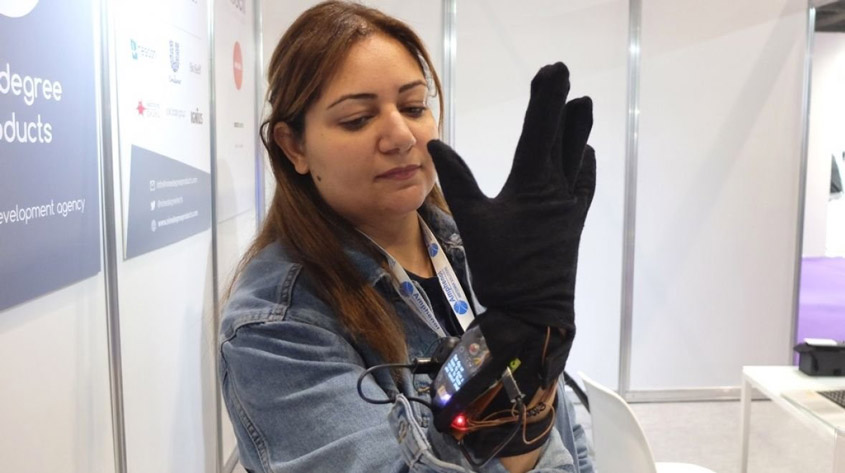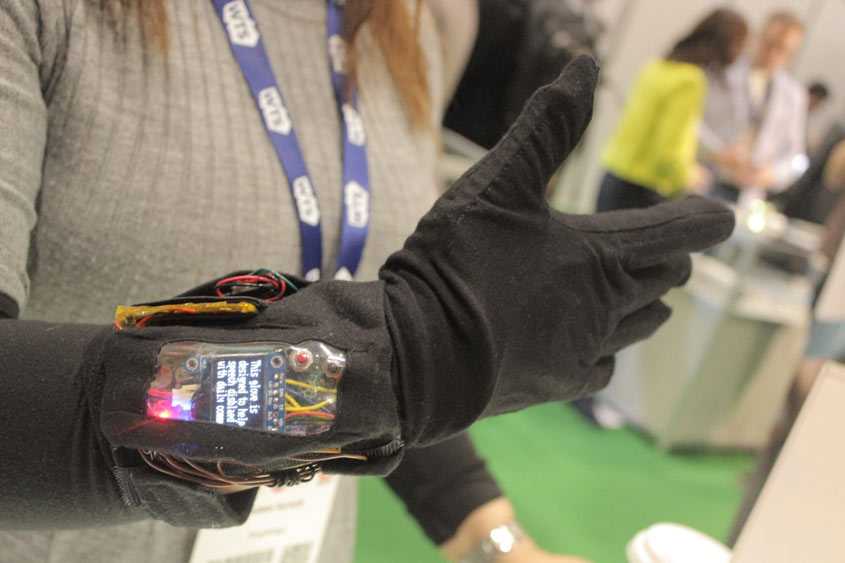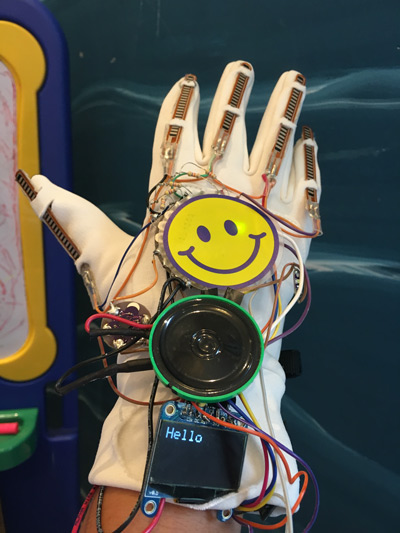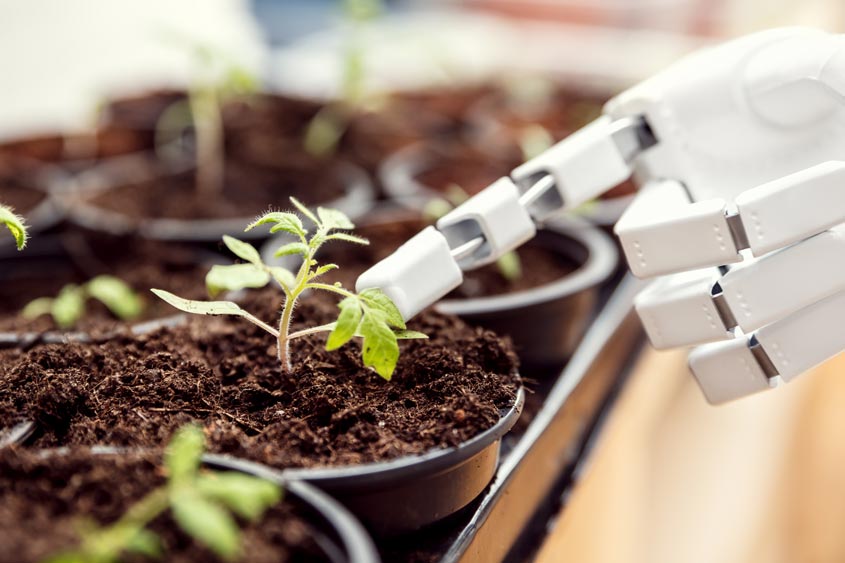By Catherine Jewell, Publications Division, WIPO
Millions of people around the world use sign language to communicate and rely ona friend or a relative to interpret those signs on their behalf. Saudi inventor HadeelAyoub, founder of the London-based startup, BrightSign, talks about how she cameto develop BrightSign, an AI-based smart glove that allows sign language users tocommunicate directly with others without the assistance of an interpreter.

What prompted you to start developing assistive technology?
I started developing the glove as part of my PhD degree, which focused on the use of gesture recognition for wearable technology. I was chosen by my University to take part in a hackathon organized by IBM for artificial intelligence (AI) for social care, and began looking for an application for gesture recognition with community impact. As I know sign language, it was easy for me to adapt and test the system I had been working on to recognize gestures for sign language and to translate them into speech. At first, the system was very simple, but the response I received after winning the IBM Hackathon, which highlighted that there was a real need for the technology, convinced me to make its development the focus of my research.
What is the scale of the actual need for this type of technology?
Millions of people around the world use sign language as their primary language. The statistics are glaring. Seventy million people are profoundly deaf and 230 million others are hearing impaired or can no longer speak because of conditions such as autism or stroke. On top of that, 90 percent of deaf children are born to hearing parents and only 25 percent of those parents can sign, so communication can be a huge problem.
Our market analysis shows that just 2 percent of people with hearing impairment have access to the technology they need to communicate because it is either too expensive or cannot be customized to their individual needs. That is why my company, BrightSign, which I set up with my co-founder in 2017, is focusing on delivering an affordable and customizable product. Our glove is designed for anyone whose primary means of communication is sign language or who has hearing or speech difficulties. Our aim is to give a voice to all those who cannot speak.
Tell us more about your technology.
Originally, the glove came with a predefined sign language library. Users simply wore it, signed, and the glove translated their hand gestures into speech. However, after working closely with different users, I realized that people sign in different ways and use different sign language libraries. That’s why I decided to include a machine learning algorithm in the glove’s design to make it learn from the user’s own signs so that each user can train their glove with their movement and create their own customized library of signs. The glove is embedded with multiple sensors to measure, track and record the user’s individual hand movements and is paired with an application that allows the gestures to be expressed as text and/or speech. Users can also select the language (e.g. English, French, Arabic) and the voice (e.g. male, female, child) they want the glove to speak. The glove translates the gestures to text, which appears on the screen of the wristband, and then to speech via a mini speaker, which is also on the wristband. When using the app, the text appears on the screen of a paired smart device and is vocalized via the device’s speakers. The glove is, in effect, a two-way communication system that enables people with hearing or speech disabilities to communicate independently and directly with others without an interpreter. Its functionality means that people with limited movement, such as stroke victims, or elderly people with hearing loss, can also use it. Over the last two years, I have created multiple prototypes, adding new features and functionalities to personalize the technology and make it user-friendly. It has been a work in progress.
Why is it so important for the glove to be customizable?
Sign language, like spoken language, has different libraries and each individual signs in their own unique way. With our technology, each user can train their glove to their own motor abilities so that it understands and translates those signs into speech. It gives them complete control over their sign language libraries and verbal communication, making it useful for anyone with hearing or speech difficulties.
What makes your product stand out in the market?
Both the customizability and the affordability of our product are what make it stand out in the market. We will be marketing our glove at around GBP 600 (USD 740). The next available technology used by the schools we have been working with costs around GBP 2,000 (USD 2,465).
How long did it take to develop?
I have been working on the glove’s development for the last three years. Over that time, thanks to the feedback from the schools we have been working with, the technology has changed beyond recognition. We are now getting ready to move into production.
What has been the children’s reaction to the glove?
At first they saw it as a toy, but once they figured it out they were very keen to train it themselves and to communicate with others directly without the assistance of their teacher or their mother to translate for them. This heightened level of independence and freedom is exactly what we wanted to achieve.
What technical challenges did you have to overcome?
As with all wearable technology, the biggest challenge lies in reducing the size of the hardware to make it wearable, safe and user-friendly. In our case, we also had to ensure the glove was waterproof and washable so that children could play freely while wearing it without worrying about getting it wet or dirty. We tried various solutions, and are now using washable sensors. We had to overcome quite a few technical challenges to get to this final stage of development. There is a lot of interest in the glove. We have already opened pre-orders on our website. Once we have finalized the glove’s operational design, we will move into production and start filling orders, hopefully, by the end of the year.

Which markets are you targeting?
The UK is our top priority, followed by the United States. For other markets, such as the Middle East, we will license out our technology to local suppliers. This is the most feasible option because each country has its own certification requirements for innovative healthcare devices like BrightSign. It would simply be impossible for us to navigate the specific requirements of each market, so we have decided to work through local partners. The process of identifying official suppliers in both Saudi Arabia and the United Arab Emirates is well under way.
Why is it important for startups like BrightSign to protect their IP, and what role does it have in your business?
From the outset, we have recognized the importance of IP protection. Investors advised us that they would view our product more favorably with it. Very early on, I filed a patent application in the United States, but after setting up the company, our patent attorneys advised us to withdraw it. We are now going the global route by filing an international patent application under the Patent Cooperation Treaty, which covers more than 150 countries. That makes far more sense, especially as the technology has evolved so much; we now have new claims to submit and the backing of an investor. In the early days, however, we simply couldn’t afford to invest in IP protection in a big way. We decided the best way forward was to focus on developing a technology that outperformed existing technologies in terms of performance and cost. Now that we have done that and have financial backing, we are actively protecting our hardware and electronics ahead of our formal product launch at the end of the year. IP protection is hugely important to us, especially in light of our plans to license our technology to local partners and the need to protect ourselves against any copycats that may try to freeride on our work.
The BrightSign glove has won multiple awards. How have these helped your business?

prototypes with new features and functionalities added to each new
version to personalize the technology and make it user friendly
(photo: Courtesy of BrightSign).
Many of the awards were organized by large corporations with big media partners. That meant we received great media exposure. For example, we won The AI for Social Care Award from IBM in 2018; The Technology Playmaker Awards ’18 (Community Impact Award category) by Booking.com; and the 2018 AXA Health Tech and You Awards (Women Entrepreneurs in Health Tech category) by AXA PPP Healthcare. This success led to feature stories about our work in outlets like The Guardian and Forbes. We were also guests on the BBC’s “One Show,” watched by around 6 million viewers. These awards came with little pots of money, but more importantly, they came with free marketing and advertising, which enabled us to reach millions of people. One of the awards also included an office for free in a co-working space, which meant we could share our experiences and network with other startups. That was really enriching and useful.
What is your biggest achievement to date?
BrightSign aligns perfectly with my degree. While it has been great to make an original contribution to the field of knowledge, I am even more proud of the fact that I have produced something that can help children and others all around the world.
How would you like to see your technology used?
I would like to see BrightSign give people with hearing or speech difficulties the independence and the freedom we all enjoy when we communicate with others. I want to free them from their reliance on someone to translate for them. I want to give a voice to those who can’t speak.
How do you think wearable tech will evolve?
I think wearable technology will continue to become smaller, easier, lighter, more durable and more customizable and it’s going to play an increasingly important role in our lives. In healthcare, for example, wearable tech is being used to monitor and track patients’ well-being and is already saving lives.
Do you have links with inventors in Saudi Arabia?
Yes. While I am in touch with a number of entrepreneurs and startups in the tech field in Saudi Arabia, at present, I am based in London and that is where my core network is right now. But at some point in the future I would like to go back to Saudi Arabia to share my experience and support on-going efforts to create a thriving startup scene there.
What are the next steps for BrightSign?
My first order of business is to submit my thesis! Then we are going to New Zealand to close a deal with a manufacturer so we can start filling orders by the end of the year.
What advice do you have for young girls with aspirations to get into technology or business?
Just do it. Keep your eyes on your goal and don’t listen to those who tell you it can’t be done. There will be low points, that’s fine; just get up, recover and keep going.



